National Temperance Hospital
110-112 Hampstead Road, NW1 2LT
Medical dates:
Medical character:
1873 - 1990
Acute
Throughout the 19th century drinking was widespread, even
encouraged. Alcohol was regarded primarily as a healthy substance
which had preventative and curative powers. While drunkenness was
condemned, it was regarded only as an abuse.
Clinically, alcoholic beverages were a widely prescribed treatment for
weakness or general wasting (despite uncertainties about its
nutritive value) and for various mental states such as confusion,
delirium or depression.
Patients with respiratory illness were treated with a
procedure known as 'cupping'
or 'blistering'. A small glass cup of alcohol was ignited to heat the
cup, which was then applied externally to the chest with the intention
that the inflammation of the lung would be transferred to the skin and
thereby relieved. The resulting blister was then lanced.
The growing temperance movement believed the use of alcohol in
hospitals impaired both staff efficiency and patient recovery. An
apothecary, Dr C.H. Yewen, established a temperance dispensary in 1860
in Upper Park Place, North West London. On 17th February 1871 Dr Yewen
suggested at a meeting chaired by Samuel Bowly, the President of the
National Temperance League, that a hospital be founded on temperance
principles, that is, in which the use of alcohol, while not forbidden,
was strongly discouraged.
A committee was formed and, in 1873, a lease was obtained for 21 years for No. 112 Gower Street and the London Temperance Hospital received its first patients in October the same year. A Board of Management, consisting of 12 total abstainers, was appointed to manage the Hospital.
In 1875 a fund was established to raise money for a larger
building. A plot of land next to St James' Church in Hampstead Road,
the previous site of the Hampstead turnpike, was purchased and the
foundation stone laid in 1879. The English-born American
financier, Samuel Insull, donated $160,000 towards the project.
The first part of the new Hospital, the east wing, was officially
opened in 1885 by Dr Frederick Temple, Archbishop of York.
In 1892 the Duchess of Westminster opened the children's ward.
In 1893, at the request of the Metropolitan Asylums Board, 12 beds were
set aside for cholera victims.
By 1904 the Hospital had been extended by a new block. The new
wards contained all the latest improvements, such as glazed walls and a
scullery where lighter meals could be prepared. The new, small
operating ward, made of metal and glass, contained one bed where a
patient could be kept for a few days following a serious operation in
aseptic conditions not obtainable in an ordinary ward.
An outside emergency staircase had been added to the old block, but the
Nurses' Home inside the building, originally paid for by the Cadbury
family, was now too small to house all the nursing staff. The
Out-Patients Department, in the vicarage of St James' Church, was
separated from the Hospital by the church, with no covered walkway
connecting it to the main building. Despite being small, dark and
uncomfortable, the Department saw some 62,000 attendances in 1903.
In 1906 the vicarage was demolished and the foundation stone laid on 25th October for a new Out-Patients Department.
During 1913 and 1914 an Ear, Nose and Throat Department and a
Skin Department opened.
During WW1 the Hospital became a section hospital to 1st London (T.F.) General
Hospital, with 34 beds for wounded and sick servicemen.
A new Nurses' Home was built in 1928 as a memorial to Sir
Thomas Vezey Strong (1857-1920), once Chairman of the Hospital, who
had been a keen and enthusiastic worker in the temperance movement.
The new building was named after him - the Vezey Strong Memorial
Home. It contained three bedrooms for Sisters, 30 for nurses and
six bathrooms. On top of the building was an operating theatre,
anaesthetic and recovery rooms, surgeons' rooms and a sterilising room.
Other additions and alterations included an X-ray room with
darkroom, a kitchen and dining room, offices, waiting rooms and an
isolation department with two wards and a nurse's room.
In 1932 the Hospital changed its name to the National Temperance
Hospital.
During WW2 it served as a casualty station.
The Hospital joined the NHS in 1948 under the control of the Paddington Group Hospital Management Committee, part of the North West Metropolitan Regional Hospital Board. In 1954 it had 158 general beds.
During the 1960s a number of beds were set aside for use by the Eastman Dental Hospital in order to reduce the dental waiting list.
On 1st January 1968 the private patient beds in the Insull Wing closed and, on 1st April, the Hospital merged with University College Hospital. Its Casualty Department then closed, with all trauma cases being referred to UCH.
In May and June 1969 the Camden Chest Clinic, the St Pancras Chest Unit and the UCH Asthma and Allergy Clinic were transferred to the Hospital.
By 1979 the Hospital had 132 beds.
It closed in 1990 as an acute hospital. University College
Hospital took over the buildings for administrative
offices. From 1992 until about 2004 Camden and Islington
Community Health Services NHS Trust also established various
clinics and offices on the site.
|
Present status (October 2011) The Medical Foundation for the Care of Victims of Torture was based here briefly in its early years. In 2006 the Medical Research Council (MRC) purchased the Hospital for £28m with a view to relocating the National Institute for Medical Research there from their 47 acre site in Mill Hill to central London. But the project hit problems; the 0.9 acre site was considered much too small. A larger site nearby, behind the British Library, was chosen for the MRC's Francis Crick Institute. However, great concerns have been expressed about the siting of the country's highest level containment facilities in central London, where the building could be a target for international terrorists or animal extremists. The Hospital buildings have been vacant for several years and are now in a near derelict state. There have been calls for the site to be used for affordable housing but, if the projected High Speed 2 (HS2) rail link is built (as currently planned), the buildings will be demolished and their site used as a construction base. |
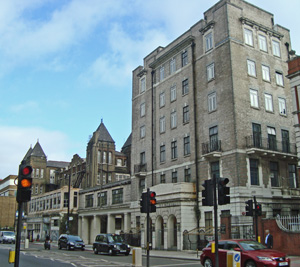
The Hospital frontage along Hampstead Road, as seen from the south.
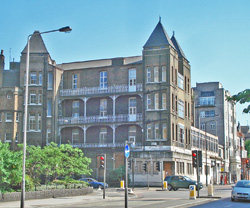
The north end of the ward blocks on Cardington Street, with the Hampstead Road frontage on the right.

The ward block on the corner of Cardington Street and Hampstead Road.
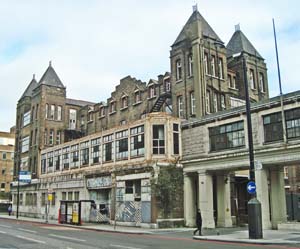
The glassed-in walkway in front of the ward block along Hampstead Road (above and below).
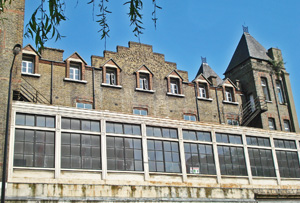
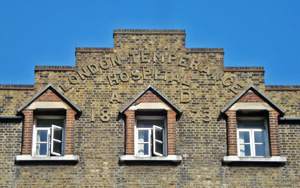
On the gable of the ward block the name of the Hospital can just be discerned.
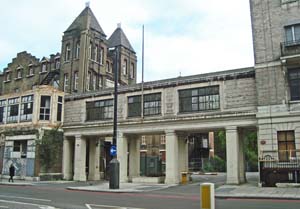
The entrance to the Hospital from Hampstead Road is through an archway.
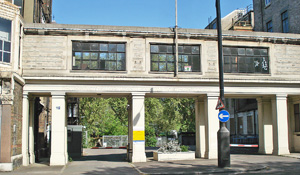
The glassed-in walkway
linking the Insull Wing to the ward blocks of the Hospital. The
lettering across it for the name of the Hospital has now been
removed.
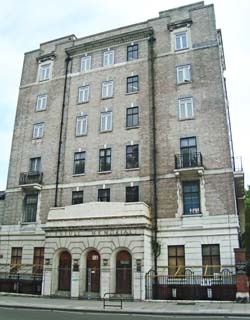
The Insull Wing at 110
Hampstead Road.
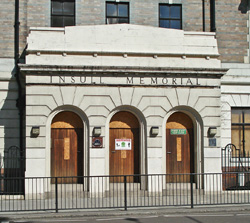
The entrance to the
Insull Wing is now boarded up.
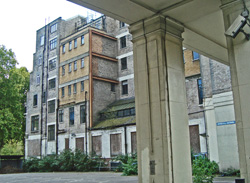
The Insull Wing from
inside the courtyard beyond the archway.
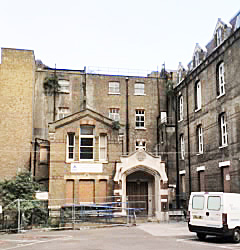
The Hospital entrance in the courtyard, opposite the Insull Wing.
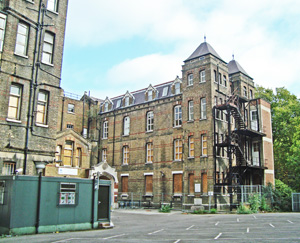
The Vezey Strong Wing at 112 Hampstead Road is inside the courtyard, to the right of the entrance door.
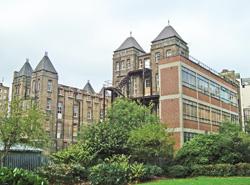
The rear of the Hospital buildings, as seen from St James' Gardens (above and below).
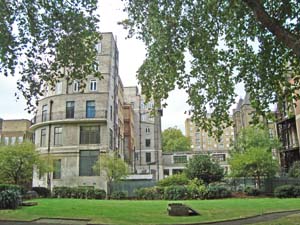

Nothing to do with the Hospital, but the attractive red brick building adjacent to the Insull Wing, at 108 Hampstead Road, was once the Saint Pancras Female Orphanage.
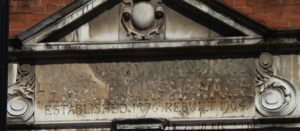
The damaged inscription above the door states that the Orphanage was established in 1776 and rebuilt in 1904. Today it is St James' House, used by the Margarete Centre.
References (Accessed 25th April 2015)
(Author unstated) 1904 A Home Hospital.
The London Temperance in Hampstead Road. Our Hospitals and
Charities Illustrated (June). London, Kegan Paul Trench
Trubner & Co. Pp. 16-18.
(Author unstated) 1917 List of the various hospitals treating
military cases in the United Kingdom. London, H.M.S.O.
(Author unstated) 1932 The
hospital World. British Journal of Nursing (March), 80.
Frame JA 1973 Alive and Lively, 100 years later: A Centennial
Report on the National Temperance Hospital, 1873-1973. London,
University College Hospital
http://28dayslater.co.uk
http://blackcablondon.net
http://discovery.nationalarchives.gov.uk
http://docs.novaloca.com
http://en.wikipedia.org
http://flickeringlamps.com
http://forever-changes.com
http://newlondondevelopment.com
www.bbc.co.uk
www.biab.ac.uk
www.camdennewjournal.com
www.camdenreview.com
www.derelictlondon.com
www.flickr.com (1)
www.flickr.com (2)
www.geograph.org.uk
www.guerillaexploring.com
www.islingtontribune.com
www.kentishtowner.co.uk
www.ravishlondon.com
www.ucl.ac.uk
www.westendextra.com